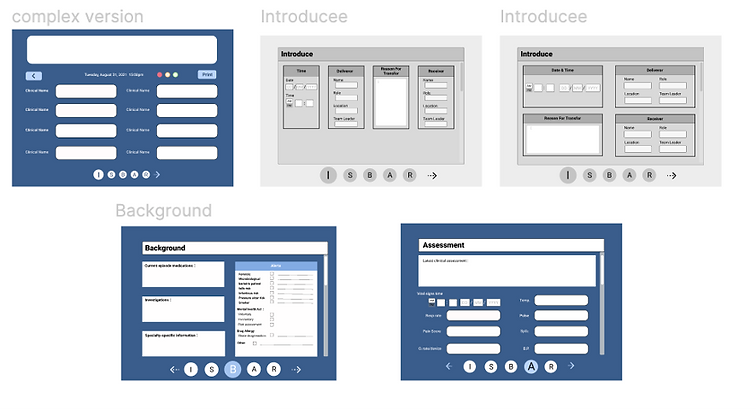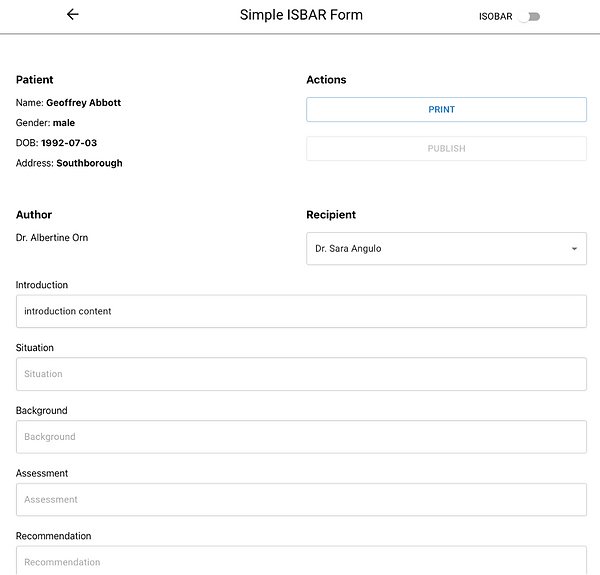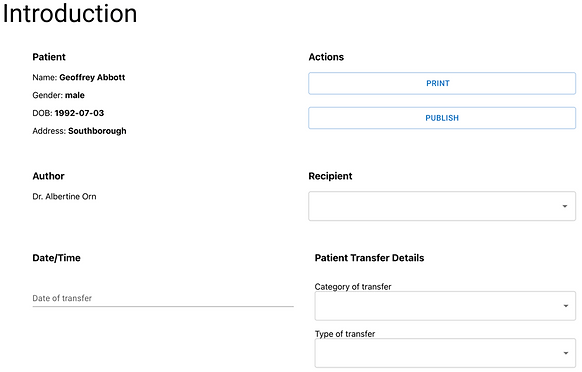
ISBAR Care Handover
Project Duration
10.08.21 - 12.11.21
Thirteen weeks
My Role
UX research
Designer
Project Overview

Design Introduction
Challenge
Over the years, studies have identified that communication problems often occur during clinical handover processes. For example, a recent large project of the European Commission found that 25% to 40% of adverse events are caused by the handover process (S. Eggins and D. Slade, 2015). Possible reasons for this result include lack of standardisation for handover processes, misreading clinicians' handwriting and memory deviation.

Team project
Our team's project is to develop an ISBAR handover form in the form of SMART on FHIR application. The purpose of this application is to enable healthcare students to adapt to electronic healthcare systems in advance by providing an online learning tool to simulate clinical handovers using ISBAR forms.
Design Question
How might we improve the efficiency and safety of clinical transfers and practice completing handover forms for medical students?
Project Milestone
Milestone 1
Milestone 2
Milestone 3
Milestone 4
Week 1
Week 2-3
Week 4-8
Week 9-13
Research of current states and identifying opportunity space
Initial design ideations,
wireframe design,
meet with customers to review feedback,
design iterations
Prototype design,
Testing,
System code implementation
Simple version complete
Complex version prototype design & testing,
System code implementation
Complex version complete
Evaluation
Research Overview
We conducted extensive research of relevant literature related to the clinical handover.

Research Insights
Allow effective input of handover information (ideally just one click)
Simple, informative, time-saving and practical
Avoid duplicate data entry and ensure that the information viewed is accurate and up-to-date
Allow efficient tracking and navigation
Avoid too "fragmentation" of the program
"who, what and when" enter a copy of the handover
information
Application requirements
Efficient input scheme for handover information
Avoid duplicate data entry
Allow efficient tracking and navigation
Time-saving
Avoid process fragmentation
Two versions
-
Simple version: simulates a verbal handover process, allowing clinicians to get a quick overview of all aspects of a patient at a glance. This version should meet the need for efficient input, saving time in conveying information.
-
Complex version: Presents the five sections of clinical information with more detail and constraints, and pre-fill the fields that contain known information. The presentation should be easy to understand by utilising forms and cards.
The application should be able to print the ISBAR form in the form of pdf documents to allow distribution
Low-fi Prototype

( Simple version )

( Complex Version Pages )
Medium fidelity prototype

Simple ISBAR - Second Iteration )

( Complex ISBAR - Second Iteration )
High fidelity prototype

( Home Screen )

( Simple application for published form)
Testing
-
Usability Test
We set several tasks for the users to complete and used the think-aloud method during the testing. Observation and interviews were also utilised to gain further insights relevant for design evaluation.
-
Functionality Test
The second user test was mainly to test the functionality of our working application, and our client, Ben, was invited to do the testing.
Implementation
For UI elements of the application Material UI (MUI) was used. MUI allowed visual consistency throughout the application, which was one of the key criteria related to the usability of our application; minimising cognitive load.
One of the requirements for the application was printing the ISBAR form in .docx or .pdf format. To meet this requirement the React-PDF library was used, which allowed pdf generation directly from a React application.
Simple and complex ISBAR forms are separate - they use completely different sets of resources, and each version is complete by itself. Moreover, the purpose of the simple and complex version is completely different: the simple version was to simulate verbal handover, while the complex version was a representation of the physical ISBAR handover form.
Outcome
Complex ISBAR form

I


S


B


A
